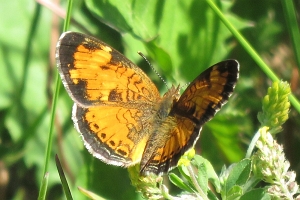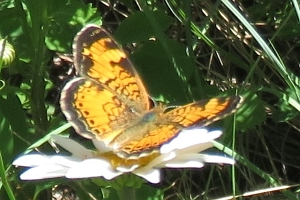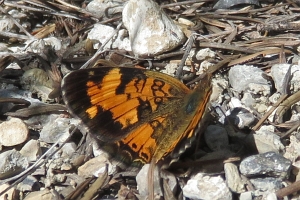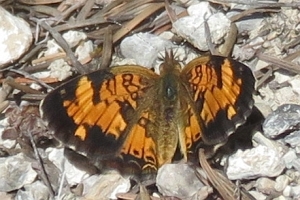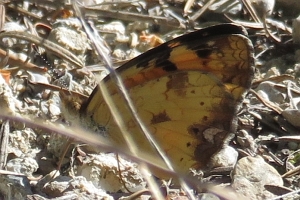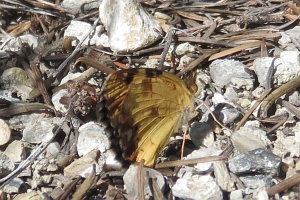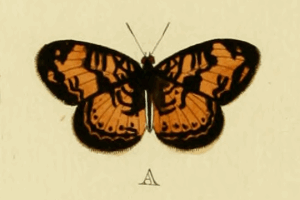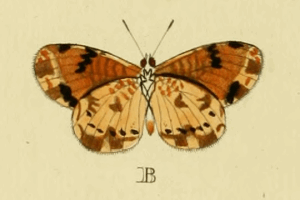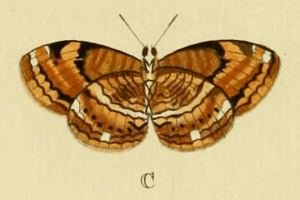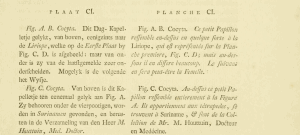2. Diagnose
2.1. Erstbeschreibung, darin indizierte Abbildungen und Text zu diesen
3. Weitere Informationen
3.1. Andere Kombinationen
- Papilio cocyta Cramer, [1777] [Originalkombination]
3.2. Unterarten
- Phyciodes cocyta selenis (Kirby, 1837) [Unterart nach funet.fi]
- Phyciodes cocyta pascoensis Wright, 1905 [Unterart nach funet.fi]
- Phyciodes cocyta diminutor Scott, 1998 [Unterart nach funet.fi]
- Phyciodes cocyta arenacolor Austin, 1998 [Unterart nach funet.fi]
- Phyciodes cocyta incognitus Gatrelle, 2004 [Unterart nach funet.fi]
3.3. Taxonomie und Faunistik
Nach [Global Biodiversity Information Facility] kommt die Art in Kanada und in den USA vor.
Der älteste Name für dieses Taxon ist "Papilio morpheus Fabricius, 1775" mit Typenfundort "America boreali" - da dieser jüngeres Homonym zu Papilio morpheus Pallas, 1771 ist, steht er nicht als gültiger Name zur Verfügung.
Locus typicus gemäß der Erstbeschreibung von Cramer ([1777]: 7) könnte Suriname sein, doch Surinam als Typenfundort war auf jeden Fall falsch, denn die Art ist ganz auf Nordamerika beschränkt.
Pelham (2008: 389) geht näher auf die Arbeit von Cramer, [1777] ein und trägt zur Klärung bei:
"a. Phyciodes cocyta cocyta (Cramer, 1777)
Uitl. Kapellen 2(9): 7, pl. 101, figs. A ♂ D, B ♂ V, [C ♀ V] (not the same species); (16): 148 (index).
Original Combination: Pap[ilio]. Nymph[alis]. Phaler[ata]. Cocyta
Type Locality: Not stated for figs. A and B, “Surinamen” “Suriname” for fig. C; neotype from “Black Rock, Cape Breton, Nova Scotia.”
Types: Neotype in AMNH, designated by Scott (1994), Papilio (n.s.) 7: 36, fig. 111 ♂ D."
Scott (1994: 36) hatte die Festlegung seines Neotypus gut begründet: "NEOTYPE male cocyta from Nova Scotia (fig. Ill; deposited in AMNH) that matches the peculiarities of cocyta fig. A very well, with very large orange areas on upf and uph and a strong submarginal uph pale line (except the unh marginal crescent is cream on fig. B, light-brown on neotype, a variable trait). This neotype (fig. 1 1 1) has orange antenna club, left hindwing smaller than right, and its pin has two labels: 1) Black Rock, Cape Breton, Nova Scotia June 23, 1983 L. P. Grey; 2) NEOTYPE [underlined with red] Papilio cocyta Cramer 1777, designated by James A. Scott Feb. 1994. (A second male from Black Rock in my coll., fig. 110, is rather ordinary selenis with orange antenna club and postmedian black line present only on rear of large orange area on each wing.) P. cocyta is therefore the proper name, and the type locality is the locality of the neotype in Nova Scotia. I realize that historically there may be little or no evidence that the original lost type of cocyta came from Nova Scotia (it certainly did not come from "Surinam" the erroneous locality of the female syntype fig. C), but Nova Scotia is on the coast where commerce with Europe was frequent, and the neotype designation and its type locality are valid regardless of history; Nova Scotia is also a good place for the neotype because P. tharos is absent there."
(Autoren: Erwin Rennwald & Michel Kettner)
3.4. Publikationsjahr der Erstbeschreibung
Nach Hemming (1958: 41) wurde der gesamte Band 1777 publiziert.
(Autor: Jürgen Rodeland)
3.5. Literatur
- Erstbeschreibung: Cramer, P. („1779“) [1777]: De uitlandsche kapellen voorkomende in de drie waereld-deelen Asia, Africa en America 2: 1-151, pl. XCVII-CXCII. Amsteldam (S. J. Baalde), Utrecht (Barthelemy Wild). [Digitalisat auf archive.org]
- Hemming, F. (1958): Opinion 516. — Opinions and Declarations Rendered by the International Commission on Zoological Nomenclature 19 (1): 1-44. London.
- Pelham, J.P. (2008): A Catalogue of the Butterflies of the United States and Canada: With a Complete Bibliography of the Descriptive and Systematic Literature. — Journal of research on the Lepidoptera, 40: 1-658. [Digitalisat auf archive.org]
- Scott, J.A. (1994): Biology and systematics of Phyciodes (Phyciodes). — Papilio (New Series), 7: 1-120, 227 figs., 12 tbls. [Digitalisat auf archive.org]




![Vorkommen in den Vereinigten Staaten von Amerika (USA) [Global Biodiversity Information Facility]](/res/img/flag/us.gif)
![Vorkommen in Kanada [locus typicus des Neotypus: Black Rock, Cape Breton, Nova Scotia]](/res/img/flag/ca.gif)
